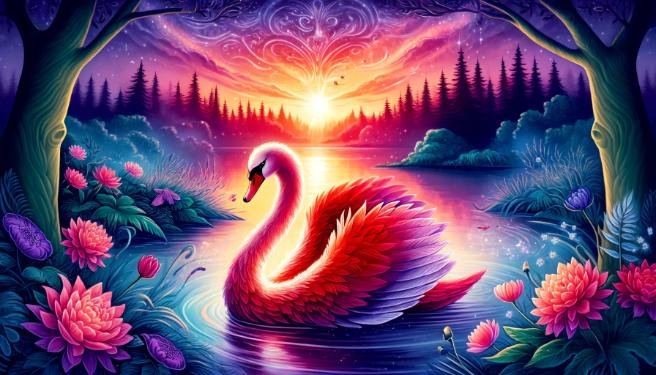Embark on a magical journey through the enchanting world of Native American folktales – The Red Swan. This captivating story, deeply woven into the fabric of indigenous mythology, offers a glimpse into the rich cultural tapestry of Native American history and spirituality. Let’s delve into the folklore that has carried the voices of the past into our present, revealing tales of magic, family, and the resilience of the human spirit.
The tale of The Red Swan has been passed down through generations, narrating the saga of three brothers who embark on a path of discovery and growth. As we uncover their adventures, we also explore the lessons they offer us about life, love, and the pursuit of the extraordinary. So, gather around the fire, as we retell the legend that has captured the hearts and imaginations of many.
What are the origins of the red swan tale?
The origins of The Red Swan tale are as mysterious as they are ancient. Rooted in the oral traditions of the Native American people, this story, like many others, was used to pass wisdom and knowledge from one generation to the next. The Red Swan story is a testament to the power of storytelling and the importance of keeping cultural narratives alive.
While the exact origin of the tale is unknown, it is believed to have been shared among the woodland tribes of North America. The story likely evolved with each telling, shaping the mythology and embedding itself within the cultural consciousness of these communities.
Folktales play a crucial role in preserving the beliefs, values, and histories of Native American tribes. The Red Swan is no exception, as it encapsulates the essence of indigenous storytelling and its spiritual significance.
Who are the main characters in the red swan story?
The central figures of The Red Swan story are three brothers, each with their unique strengths and destinies. Maidwa, the eldest, is known for his wisdom and leadership. Deep Voice, the middle brother, carries the power of song and sound. And the youngest, known as Red Thunder’s child, is gifted with bravery and a pure heart.
These siblings are thrust into a world of wonder and challenge after experiencing a family tragedy. As they navigate their new reality, they encounter various mystical beings and natural forces that aid them on their quest.
The most mystical being they encounter is the Red Swan herself, an ethereal creature whose beauty and mystery propel the brothers, especially the youngest, on a quest that symbolizes the pursuit of the extraordinary in folklore.
How does the red swan reflect native american culture?
In the tapestry of Native American culture, The Red Swan is more than just a tale; it is a reflection of the deeply held beliefs and values of indigenous people. The story embodies the interconnectedness of humanity with nature, a fundamental aspect of Native American worldviews.
The use of magic arrows by the youngest brother to pursue the Red Swan echoes the cultural significance of respecting and harnessing the power of the elements. The narrative also highlights the importance of familial bonds and the role of animals as guides and protectors.
The Red Swan also serves as a vessel for the exploration of themes such as love, sacrifice, and transformation, which are recurrent in Native American myths. The story encourages listeners to contemplate their place in the world and the impact of their actions on the environment and community.
Where can the red swan folktales be found?
Folktales such as The Red Swan can be found in the oral histories of Native American tribes, as well as in the work of historians and folklorists dedicated to preserving these stories. Many of these tales have been documented in books, academic papers, and online platforms, ensuring their accessibility to a broader audience.
Libraries, museums, and cultural centers often hold collections that include Native American folktales. Additionally, tribal elders and storytellers continue to share these stories within their communities, keeping the tradition of oral storytelling alive.
The digital age has also allowed for the broader dissemination of these tales, with websites and digital archives providing platforms for the stories to be shared and preserved for future generations.
What themes are explored in the red swan myths?
The Red Swan myths are rich with themes that transcend time and culture. Central to these is the theme of transformation, both literal and metaphorical, as characters undergo profound changes in pursuit of their goals.
Themes of bravery and perseverance shine through as the brothers face trials and tribulations, teaching lessons about overcoming adversity. The significance of dreams and visions is another recurring theme, highlighting the spiritual aspect of Native American culture.
Additionally, the story explores the delicate balance between humans and nature, emphasizing the respect and reverence for the environment that is characteristic of indigenous beliefs.
- Transformation and metamorphosis
- Bravery and perseverance in adversity
- The significance of dreams and spiritual visions
- Respect for nature and the environment
Can the red swan tale teach us about modern life?
Despite originating from a time far removed from ours, The Red Swan tale holds valuable insights for modern life. The story encourages us to embrace the unknown and to pursue our dreams with determination and courage.
It also serves as a reminder of the importance of staying connected to our roots and valuing the wisdom of our ancestors. In a world where technology often distances us from nature, The Red Swan inspires a return to the simplicity and beauty found in the natural world.
Furthermore, the tale highlights the timeless nature of family and community. It reminds us that our actions have consequences that extend beyond ourselves and that we are all part of a larger narrative.
In conclusion, The Red Swan is more than a folktale; it is a living legacy of Native American culture, offering both a window into the past and a mirror reflecting the universal human experience. As we cherish these stories, we honor the spirit of the indigenous peoples and the enduring wisdom they impart.


Leave a Reply